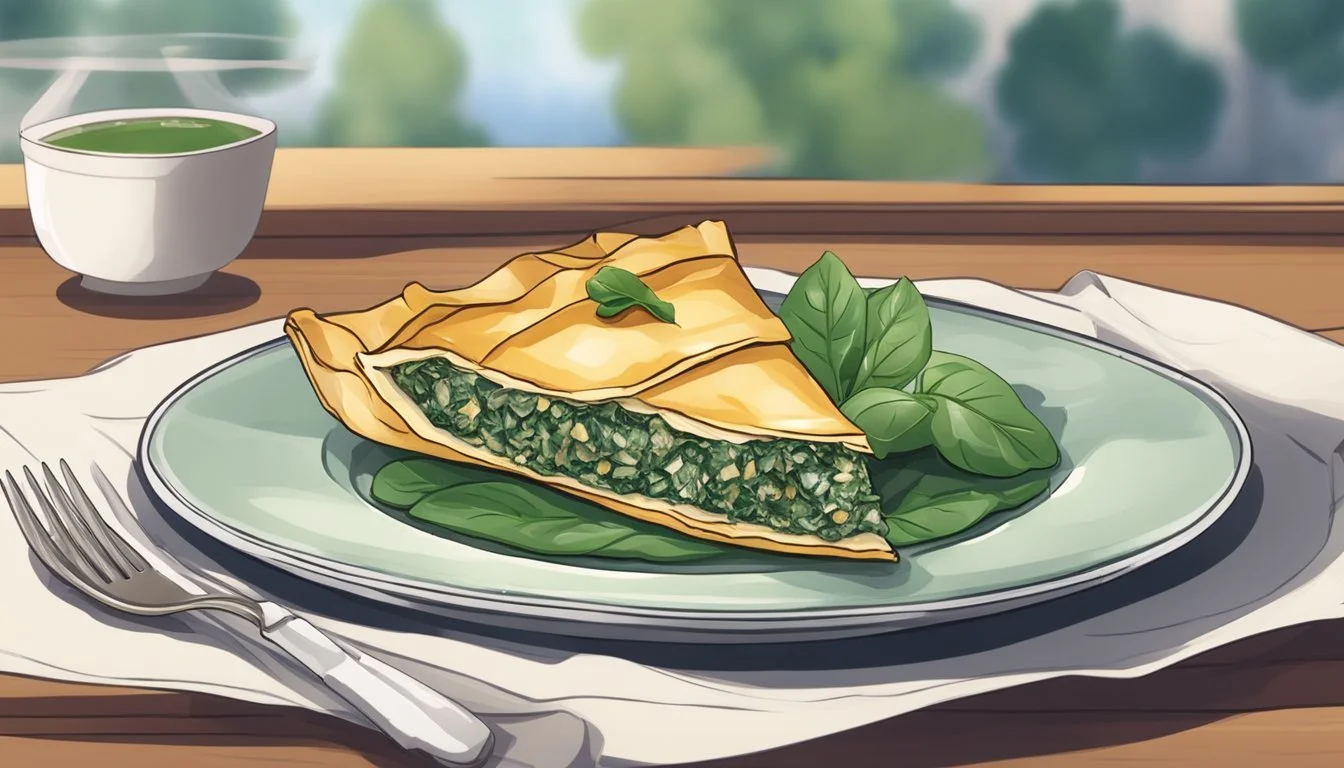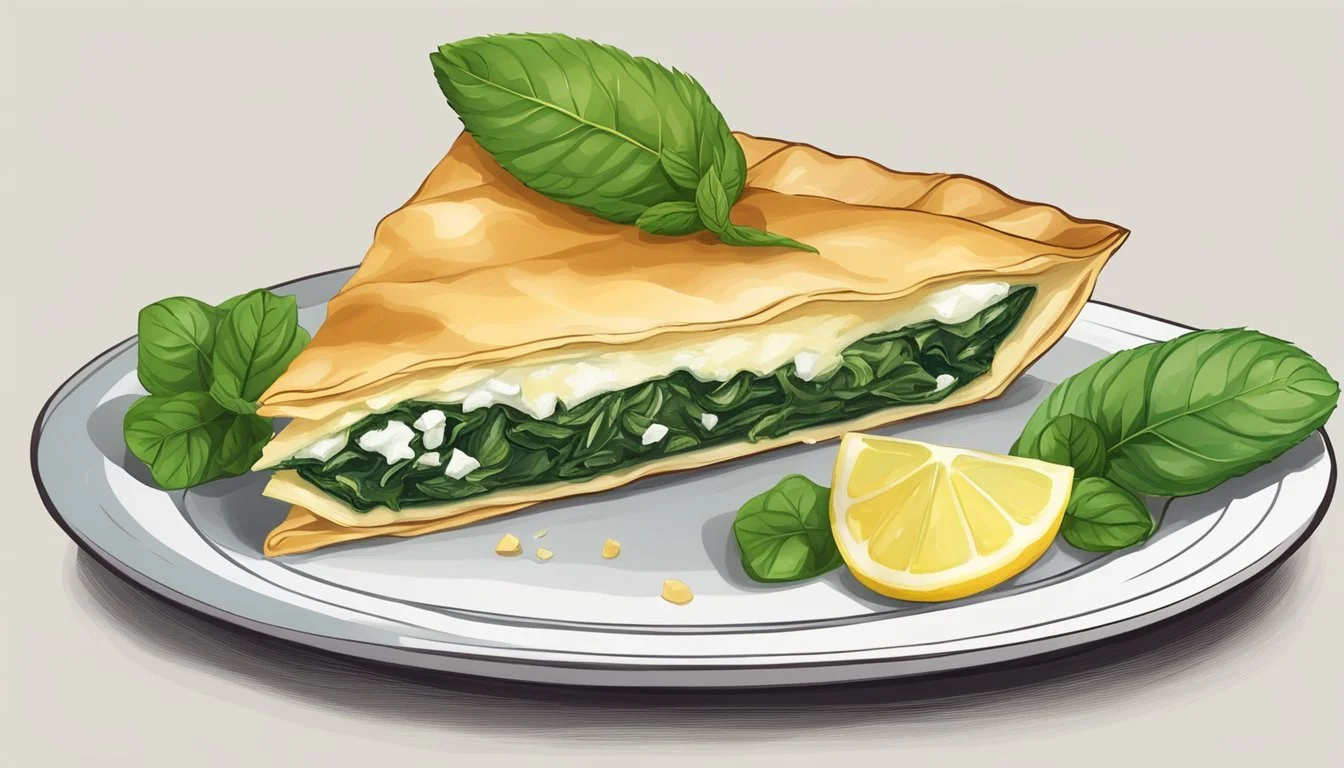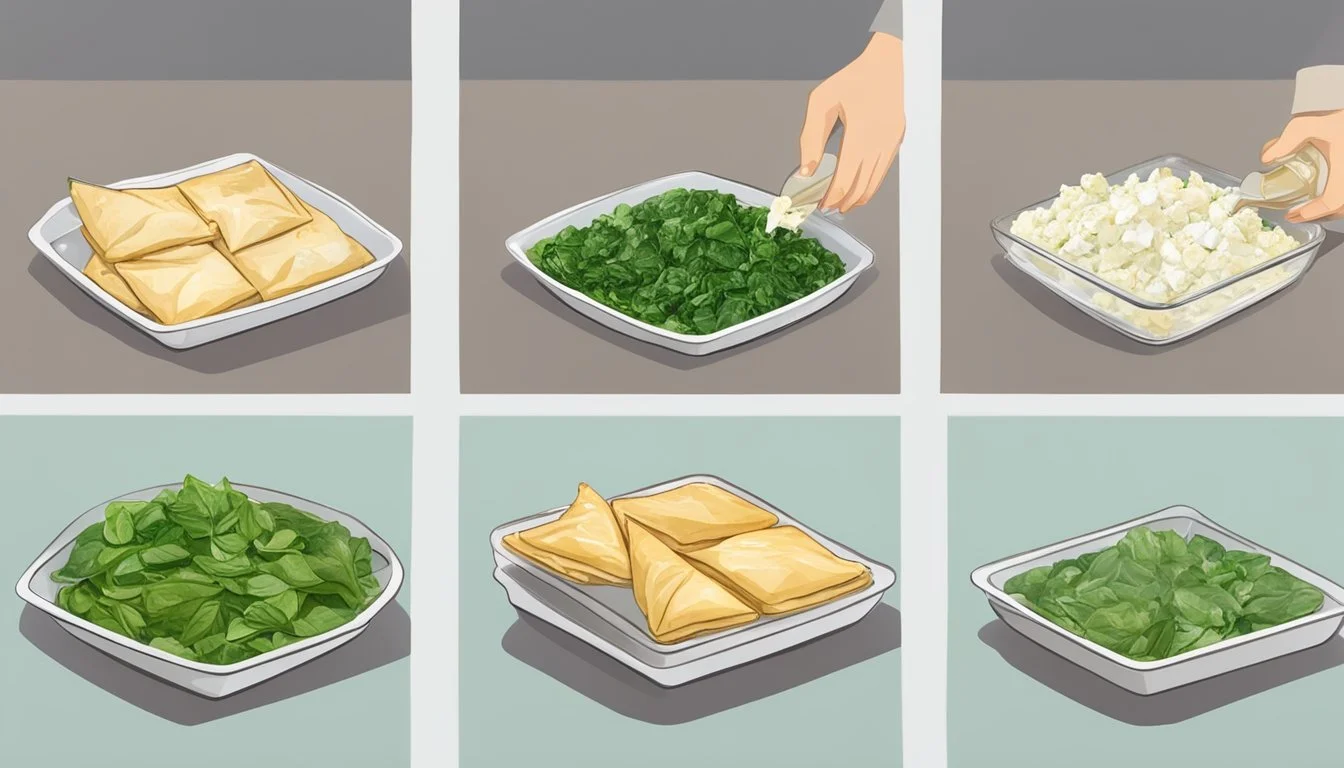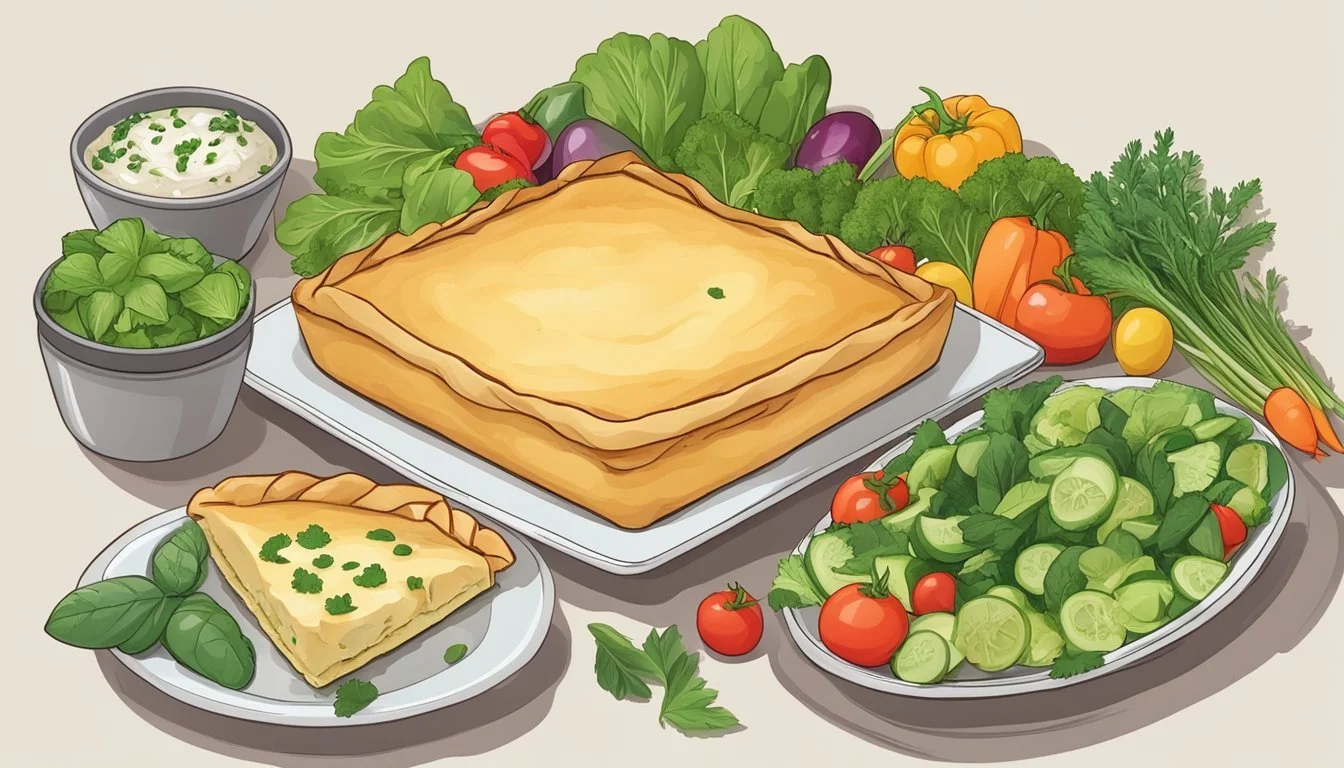How do you eat a spanakopita?
A Guide to Enjoying This Greek Savory Pastry
Spanakopita is a traditional Greek dish that delights with its flaky phyllo pastry, rich spinach (What wine goes well with spinach?) filling, and hints of feta cheese. This savory pie is often enjoyed as a hearty snack or a tempting appetizer. Its origins can be traced back to the cuisine of the Mediterranean, where it is made by layering ingredients and baking them to a golden perfection.
Eating spanakopita can be both casual and fitting for more formal settings. Cut into squares or triangles, it is commonly served in manageable pieces that make it ideal for eating by hand. For those who prefer utensils, a fork and knife can also be used to maintain decorum, especially when the pie is served as part of a larger meal. The experience of biting into the crispy layers of phyllo, combined with the savory filling, creates a balanced taste that is both distinctive and satisfying.
While it is typically enjoyed warm to appreciate the melted feta cheese and the aroma of herbs, spanakopita can also be served at room temperature, making it a versatile choice for various occasions. The way it is consumed may vary from person to person, but the enjoyment derived from its flavors remains a constant allure. Its nutritional profile, offering a good source of leafy greens and dairy, makes it a popular choice among those who seek a delicious yet wholesome option.
Origins and Cultural Significance
Spanakopita is a revered Greek spinach pie with deep historic roots and significant cultural influence. It has been a staple in Greek cuisine, cherished for both its flavors and the culinary artistry it represents.
Historical Background
The spanakopita or Greek spinach pie is believed to have ancient origins, with a presence in Greek culinary history that dates back to the era of the Greek nobility. This savory pie has evolved over time, with regional variations adding depth to its rich history. The pie's essential ingredients—spinach, feta cheese, and phyllo dough—are thought to have been combined hundreds of years ago, creating what would become one of Greece's most iconic dishes.
Culinary Tradition
In terms of Greek recipes, spanakopita holds an esteemed place among both authentic and modern creations. Traditionally, the pie combines the fresh, iron-rich flavors of spinach with the tangy, creamy notes of feta cheese, all encased in layers of delicate, buttery phyllo pastry. It is often served with a Greek salad as part of a mezze platter or as a hearty main dish, reflecting the versatility of Greek cuisine.
Popularity Globally
Globally, spanakopita's appeal extends far beyond the borders of Greece, becoming a beloved feature in international Greek recipes. Its popularity has soared as people internationally have embraced Mediterranean flavors, with spanakopita being no exception. Today, it is enjoyed worldwide, often found in Greek specialty shops, international food markets, and has become a favorite at culinary events showcasing authentic Greek fare.
Basic Ingredients
Spanakopita, a traditional Greek spinach pie, combines a rich variety of ingredients that blend to create its distinctive taste and texture. Freshness and quality of these components are essential to ensure the authenticity and flavor of the dish.
Key Components
The foundation of a classic spanakopita is spinach, which provides the pie with its signature green hue and a source of iron and protein. Typically, fresh spinach is preferred for its taste and nutritional value, although baby spinach is a suitable alternative due to its tender texture. Eggs act as a binding element within the mixture, holding the filling together, while butter or olive oil is used to achieve a flaky and golden crust when brushed onto the phyllo dough layers.
Spinach (fresh or baby spinach)
Eggs
Olive oil or Butter (for brushing)
Seasonings and Herbs
To elevate the flavor profile, a variety of seasonings and fresh herbs are incorporated. Dill (how long does dill last?), parsley, and fresh mint are commonly used for their aromatic qualities. Seasonings like salt and black pepper are added to taste. Nutmeg offers a hint of warmth and complexity. For an added zest, a squeeze of lemon juice complements the greens, and entities such as garlic cloves or finely chopped yellow onions and spring onions provide a savory depth.
Salt and Black Pepper
Fresh Parsley, Dill, and Mint
Nutmeg
Garlic
Lemon
Onions (yellow, green, or spring onions)
Cheese Varieties
A blend of cheeses contributes creaminess and tang to the dish. Feta cheese is a staple, with its crumbly texture and briny flavor. It's often paired with ricotta cheese, which adds a milder and smoother taste, or cottage cheese (how long does cottage cheese last?) for a lighter consistency. Some variations may include cream cheese (how long does cream cheese last?) for extra richness or specific Greek cheese varieties such as Kefalotyri to stay true to its Hellenic roots.
Feta Cheese
Ricotta Cheese
Cottage Cheese
Greek Cheeses (like Kefalotyri)
Optional: Cream Cheese
Phyllo Dough Preparation
Properly preparing phyllo dough is critical for creating a crisp and flaky spanakopita. Key aspects include handling the delicate sheets with care, layering the pastry correctly, and brushing each layer with fat to ensure a golden-brown finish.
Handling Delicate Phyllo
Phyllo dough is notoriously fragile and dries out quickly. Upon removing it from the packaging, it should be laid flat on a clean work surface. A damp paper towel can be gently placed over the unused sheets to prevent them from drying out while working with individual pieces. If the phyllo dough is frozen, it should be thawed in the refrigerator for at least 8 hours or overnight to ensure it doesn't become soggy or stick together.
Layering Technique
The layering of phyllo sheets is a systematic process that contributes to the final texture of the pastry. Spanakopita typically requires multiple layers—usually three to four—of phyllo pastry. One should take a single sheet of phyllo and lay it in the baking dish, with the edges slightly overhanging if necessary. The next sheet should be placed over the first, offsetting it to cover any gaps.
Brushing with Fat
Each layer of phyllo sheet must be liberally brushed with a fat, such as olive oil or melted butter, using a pastry brush. This helps to achieve a crisp texture as the pie bakes. The process involves brushing the entire surface gently yet thoroughly before adding the next sheet. In between layers, any excess fat should be avoided as it can lead to sogginess rather than the desired flakiness.
When storing phyllo dough, any leftovers must be wrapped tightly in plastic wrap and refrigerated. It's advisable to use refrigerated phyllo sheets within a few days, or they can be re-frozen for a later use. Preparing phyllo pastry ahead of time is also an option; one can prepare the spanakopita to the point of baking, then cover it and refrigerate for several hours before baking to serve fresh.
Assembling Spanakopita
Assembling spanakopita involves creating layers with phyllo dough, adding the filling, and baking until golden brown. The process is methodical and requires attention to detail to achieve an authentic spanakopita recipe result.
Forming the Pie
In a baking dish, one begins by layering sheets of phyllo dough, typically brushed with olive oil or melted butter using a pastry brush to ensure crispiness throughout. It is important that each sheet overlaps the one before it, covering the bottom and sides of the dish. After the base layers are laid down, the spinach filling is evenly spread over the top.
Making Triangles and Squares
Spanakopita can be formed into individual triangles or left as a large pie and cut into squares after baking. For triangles, individual phyllo sheets are cut, filled, and folded. When making squares, the assembled pie is scored part-way through to outline each square prior to baking. This ensures a cleaner cut post-bake.
Filling and Folding Methods
The filling typically consists of sautéed spinach mixed with onions, herbs, feta, and sometimes a whisked egg to bind the mixture. For a pie, the mixture is spread over the phyllo in the baking dish, and additional phyllo layers are placed on top. For individual triangles, a small amount of the mixture is placed on each cut phyllo sheet, which is then folded over to encase the filling. Whether preparing a large pie or individual servings, the technique lies in ensuring the filling is well encased within the phyllo to prevent leakage during baking.
Cooking Techniques
To achieve the desired flaky texture and rich flavor, the correct cooking techniques are essential when preparing spanakopita. Baking is the traditional method, which allows for a delicate, golden brown, and crispy finish.
Baking
The spanakopita must be baked at a precise temperature to ensure the phyllo pastry layers achieve their characteristic crispiness. It is common to bake the dish in a preheated 325 degrees F (163 degrees C) oven. The pastry is typically brushed with melting butter or olive oil before baking to help the layers brown and crisp up. The spanakopita is placed in a baking dish and cooked until the phyllo turns a beautiful golden brown color and the texture is crispy. This process can take about 1 hour, but times may vary depending on the specific recipe and oven variations.
Alternative Cooking Methods
While baking is the traditional method, there are alternative techniques to cook spanakopita. For instance, some may choose to use a toaster oven for smaller portions or when kitchen space is limited. Additionally, air frying has become a popular method for achieving a crispy texture with less oil. However, these methods may require adjustments to the cooking time and temperature, and the results can be less consistent than the conventional oven baking method.
Flavor Pairings and Accompaniments
Spanakopita, a savory Greek pastry, is best enjoyed when complemented by side dishes and dips that enhance its flavors. This section explores suitable side dishes and sauces to pair with spanakopita for a fulfilling eating experience.
Complementary Side Dishes
Greek Salad: A classic Greek salad, with its crisp vegetables, feta cheese, and olives, (What wine goes well with olives?) dressed in olive oil and lemon juice, pairs well with the rich taste of spanakopita.
Stuffed Grape Leaves: Another traditional Greek appetizer, they offer a delightful contrast to the flaky pastry.
Roasted Vegetables: Seasoned with herbs and a touch of lemon juice, these can balance the savory notes of the pie.
Lemon Roasted Potatoes: Their citrusy profile complements the spinach and feta in spanakopita.
Sauces and Dips
Tzatziki: A refreshing and creamy sauce made with yogurt, cucumber, garlic, and dill; perfect for adding a cooling contrast to spanakopita.
Hummus: This rich, savory dip adds depth to the spinach and feta flavors of the pastry.
Garlic Bread: Can be used to scoop up dips or to enjoy on the side, providing a satisfying crunch.
Serving Suggestions
Spanakopita, a delightful Greek recipe, is versatile enough to serve as an appetizer, snack, or part of a larger meal. Whether enjoyed as triangles or squares, spanakopita's flaky crust and savory filling make it an authentic crowd-pleaser at any gathering.
Presentation Tips
One presents spanakopita on a platter in a way that accentuates its golden brown crust. If served as an appetizer or party food, the spanakopita should be cut into smaller triangles, making it easy for guests to grab and go. For an enticing display, arrange the pieces in a circular pattern or stack them in neat rows on a serving dish. Garnishing with a sprinkle of chopped herbs can add a pop of color and hint at the flavors inside.
As a side dish, it can be elegantly plated alongside vibrant Greek salad, stuffed grape leaves, or other Mediterranean fare, ensuring that the portions complement the main dish without overwhelming it. For vegetarian guests, ensure that a sufficient number of spanakopita triangles are available, as they might be the primary source of vegetarian protein in the meal.
Portioning and Cutting
A sharp knife is essential for cleanly slicing through the layers of phyllo dough to create uniform pieces of spanakopita. Whether one prefers to cut it while it’s hot and fresh out of the pot or after it has cooled a bit, the key is to use a gentle sawing motion to prevent the pastry from crumbling.
For a sit-down meal, serving one large piece or two smaller triangles per guest typically suffices. As an appetizer or at a buffet, smaller, bite-sized pieces are more suitable. They should be easy to consume in one or two bites, reducing the need for utensils and making for a convenient snack option.
Dietary Considerations
When considering how to eat spanakopita in line with specific dietary needs, it's important to look at both vegetarian and vegan adaptations as well as options for those with gluten sensitivities or allergies.
Vegetarian and Vegan Options
Spanakopita traditionally caters well to vegetarians, as its primary ingredients include spinach, a nutrient-rich superfood, and feta cheese. However, those seeking a vegan version can substitute the feta for plant-based cheese alternatives. Greek yogurt, often used for a creamy texture, can be replaced with soy or coconut-based alternatives to keep within vegan dietary boundaries.
Vegetarian Spanakopita: Includes spinach and dairy feta.
Vegan Spanakopita: Can substitute dairy with vegan cheese and plant-based yogurt.
Gluten-Free and Allergy Advice
For those with gluten allergies or celiac disease, making gluten-free spanakopita requires swapping traditional phyllo dough for a gluten-free alternative. These alternatives can be found in specialty stores or made at home, ensuring they do not contain wheat, barley, rye, or any cross-contaminated ingredients.
Common Allergens: Wheat (gluten), dairy (feta, butter, yogurt).
Gluten-Free Alterations:
Replace phyllo dough with gluten-free dough.
Check labels for cross-contamination notices.
Careful consideration of ingredients is critical for those with allergies, and substitutions are readily available for most dietary requirements.
Storage and Preservation
When handling spanakopita, one must consider the methods of storage and preservation to maintain its quality and flavor. Proper refrigeration and freezing techniques are essential for ensuring that this Greek delicacy remains delicious, whether enjoyed as a freshly made dish or as a leftover.
Refrigeration Best Practices
To keep spanakopita fresh in the refrigerator, it should be placed in an airtight container or tightly wrapped with plastic wrap. Spanakopita retains its quality in the refrigerator for up to 3-4 days. If clarified butter is used in the preparation, it can help spanakopita stay moist while refrigerated. Always ensure that spanakopita is cooled to room temperature before refrigerating to prevent condensation which could lead to a soggy pastry.
Freezing and Thawing Tips
For longer preservation, spanakopita can be stored in the freezer. Here are specific steps to freeze and thaw spanakopita:
Freezing Before Baking:
Assemble the spanakopita but do not bake it.
Place it on a baking sheet and freeze until solid.
Transfer the frozen spanakopita to a freezer-safe bag or container, label with the date, and store it for up to two months.
Freezing After Baking:
Allow baked spanakopita to cool completely.
Wrap it tightly in aluminum foil or freezer wrap and place in a freezer-safe bag.
It can be kept in the freezer for one month for the best quality. The pastry might lose some crispiness.
Thawing and Reheating:
Thaw spanakopita in the refrigerator overnight.
For reheating, place it in an oven preheated to 325°F until heated through. If it was frozen raw, bake it as per the original recipe instructions.
Using these methods guarantees spanakopita that is nearly as good as fresh, both in texture and in taste, even after freezing.
Health and Nutrition
When considering the health and nutrition of spanakopita, it's important to examine its caloric content, the beneficial nutrients it contains, and its role in a dietary context. This traditional Greek dish, when consumed in moderation, can fit into a healthy diet.
Caloric Content
Spanakopita's caloric content primarily depends on its size and the specific recipe used. A typical serving contains between 250 to 400 calories. The caloric density is influenced by the amount of phyllo dough, oil, and cheese used in preparation.
Beneficial Nutrients
Spanakopita offers various nutrients that contribute to a balanced diet:
Protein: Provided by the cheese and, to a lesser extent, the spinach, protein is crucial for muscle repair and growth.
Iron: Found in spinach, iron is vital for healthy blood cells.
Vitamins and Minerals: Spanakopita includes vitamins A, C, and K, along with minerals like calcium and manganese from the spinach and other leafy greens used.
Nutritional makeup may vary, but typical values per serving could look like this:
Nutrient Approximate Amount Calories 300 kcal Protein 10 g Iron 2 mg Vitamin A 2800 IU Vitamin C 10 mg Calcium 200 mg
Dietary Role of Spanakopita
As a nutrient-dense option, spanakopita can play a healthful role in one's diet, provided it is part of a balanced meal plan. The fiber in the spinach and the protein from the cheese make it a satisfying choice that can help with satiety. However, it should be consumed conscientiously due to the potential for high-calorie counts from added fats like olive oil and butter. It is not considered a "superfood," but it is a dish with a good balance of nutrients.











